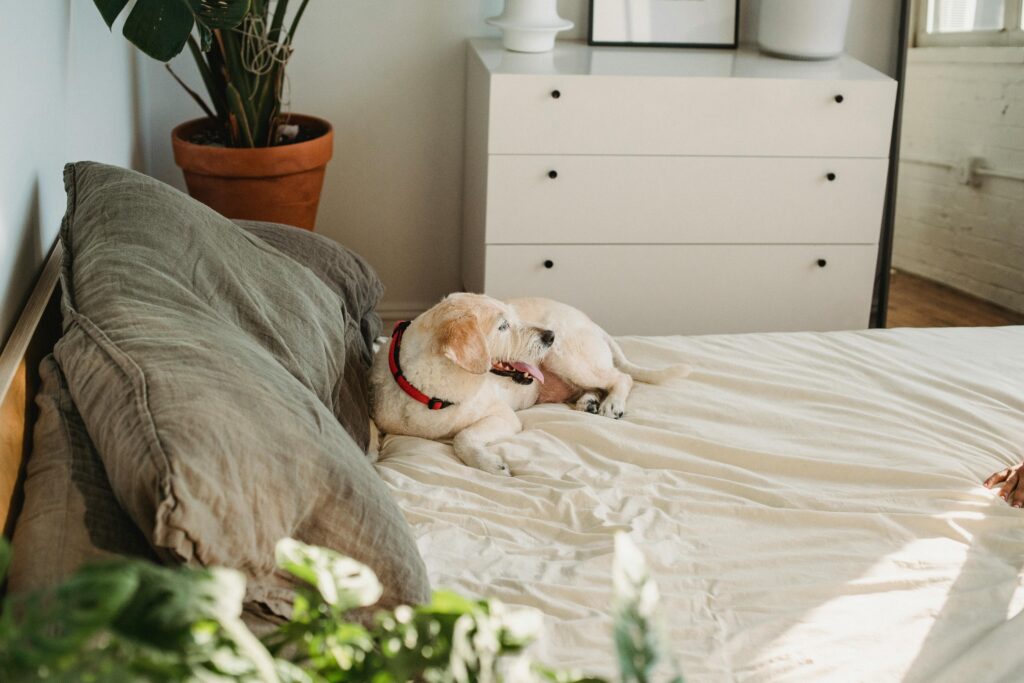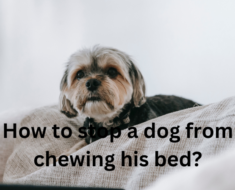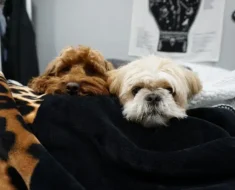Wondering how to sew a dog bed cover that’s both cozy and stylish for your furry friend? In this quick guide, we’ll show you the ropes to create a comfortable haven for your beloved pet.
Sewing a dog bed cover is simpler than you might think. With a few basic materials and some handy tips, you’ll have a custom-made cover that suits your dog’s personality and your home decor perfectly.
Here why does your dog hang his bed on bed.
Curious to learn the step-by-step process? Dive into our detailed tutorial to discover expert tips and tricks from seasoned DIY enthusiasts, ensuring your dog’s bed is not just functional but also a charming addition to your space.
Materials to make a DIY dog bed cover:
To make a DIY dog bed cover, you’ll need materials that are durable, washable, and comfortable for your furry friend. Here are some suggestions:

- Fabric: Choose a sturdy fabric like canvas, denim, or upholstery fabric for the main cover. These materials are durable and can withstand the wear and tear of daily use.
- Thread: Use a strong, heavy-duty thread that matches the color of your fabric to ensure the stitches are secure and long-lasting.
- Zipper or Velcro: Depending on your preference, you can use a zipper or Velcro strips to create a closure for easy removal of the cover for washing.
- Sewing machine or needle and thread: If you have a sewing machine, it will make the project faster and easier. However, you can also hand-sew the cover if you don’t have access to a machine.
- Optional: Piping or trimmings can add a decorative touch to the cover, but they are not necessary for functionality.
By gathering these materials, you can create a custom dog bed cover that is both functional and stylish for your pet’s comfort.
Here how to stop my dog fro peeing on my bed?
14 steps to sew a dog bed cover
Step 1: Gather Materials
Gather fabric, thread, zipper or Velcro, sewing machine or needle and thread, and optional trimmings.
Step 2: Measure and Cut Fabric
Measure the dimensions of your dog bed and cut the fabric accordingly, adding seam allowances.
Step 3: Prepare Zipper or Velcro
If using a zipper, pin and sew it onto one side of the fabric opening. For Velcro, sew strips to each side.
Step 4: Pin Fabric Pieces
Place fabric pieces right sides together and pin along the edges, leaving the zipper/Velcro side open.
Step 5: Sew Edges
Using a sewing machine or needle and thread, sew along the pinned edges, reinforcing corners.
Step 6: Clip Corners
Clip corners diagonally without cutting the stitches to reduce bulk and achieve crisp corners.
Here, why does my dog roll around my bed?
Step 7: Turn Inside Out
Turn the cover inside out through the zipper/Velcro opening, gently pushing out corners for a neat finish.
Step 8: Press Seams
Press the seams with an iron to flatten and smooth the cover’s edges for a professional look.
Step 9: Add Piping or Trimmings (Optional)
If desired, sew piping or trimmings along the edges for decorative flair and added durability.
Step 10: Insert Dog Bed
Insert the dog bed into the cover to ensure a proper fit and adjust if necessary.
Step 11: Close Zipper/Velcro
Close the zipper or Velcro securely to keep the dog bed in place and easily removable for washing.

Step 12: Secure Opening
Stitch over the zipper/Velcro ends to secure them and prevent unraveling during use.
Step 13: Check Seams
Check all seams for strength and durability, reinforcing any weak areas if needed.
Here, why did my dog poop on my bed all of a sudden?
Step 14: Finish and Enjoy
Trim any loose threads, fluff up the bed, and place it in your pet’s favorite spot for them to enjoy their new cozy bed cover.
Related faq’s
What fabric is used for dog beds?
Dog beds are typically made using durable and comfortable fabrics that can withstand frequent use and washing.
Common fabrics used for dog beds include canvas, denim, polyester blends, and upholstery fabrics.
These materials are chosen for their strength, resistance to wear and tear, and ability to provide a soft and cozy surface for pets to rest on.
Additionally, waterproof or water-resistant fabrics may be used for outdoor or crate beds to prevent moisture penetration.
Here, how to keep dog from digging in flower bed?
How do you make a homemade dog bed?
To make a homemade dog bed, follow these steps:
- Gather materials such as fabric, stuffing (foam, old pillows, or shredded fabric), scissors, thread, and a sewing machine or needle.
- Measure and cut fabric to desired size, adding seam allowances.
- Sew fabric pieces together, leaving an opening for stuffing.
- Stuff the bed with filling, ensuring it’s evenly distributed.
- Close the opening securely.
- Fluff up the bed and place it in your dog’s favorite spot.
How do you sew a hole in a dog bed?
To sew a hole in a dog bed, follow these steps:
- Gather materials like matching thread, needle, scissors, and fabric patch (if needed).
- Trim any loose threads around the hole.
- Align the edges of the hole and pin them together.
- Using a needle and thread, sew a whipstitch or running stitch along the edges, gradually pulling the fabric tight.
- Knot the thread securely and trim any excess.
- If necessary, patch the hole with a fabric piece cut to size and sew it in place.
How much fabric do I need for a dog bed?
The amount of fabric needed for a dog bed depends on the bed’s size and desired thickness. As a general guideline, for a small dog bed (20″ x 24″), you may need about 1.5 to 2 yards of fabric.

For a medium-sized bed (24″ x 30″), approximately 2 to 2.5 yards of fabric should suffice.
Larger beds (30″ x 36″ or more) may require 3 to 4 yards of fabric. Adjust these estimates based on the bed’s thickness and any additional features like piping or trimmings.
Conclusion:
In conclusion, crafting a cozy and stylish dog bed cover is easier than you think!
With these simple steps and creative fabric choices, your furry friend will have a comfortable spot to rest in no time.
Now, here’s an interactive question for you: What color scheme would best suit your pup’s personality? Share your ideas in the comments below!






